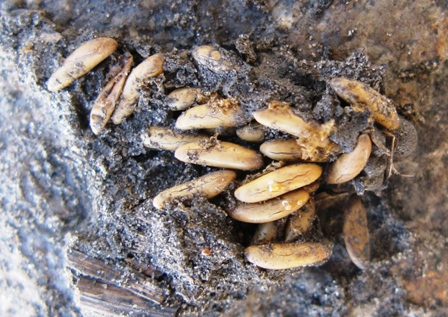Early Season Grasshopper Questions
Early-Season Species Of Grasshoppers
It is not unusual to see some grasshopper activity in April or early-May, and some of these grasshoppers may even be in advanced stages of growth. So does this means grasshoppers are emerging earlier and growing quicker than normal and are an increased risk for the coming growing season? The short answer is that any grasshopper that’s large before the end of May is not a pest species .
None of the species of larger grasshoppers you see early in the spring cause economic damage, so they should not be controlled or used as indicators of later season grasshopper problems.
Although there are numerous species of grasshoppers in Manitoba, there are 4 species that, given the right conditions, can cause significant damage to crops. These are the migratory grasshopper ( Melanoplus sanguinipes), twostriped grasshopper (Melanoplus bivittatus), clearwinged grasshopper (Camnula pellucida), and Packard grasshopper (Melanoplus packardii ). The species of grasshoppers that are considered crop pests all overwinter as eggs.
Regarding the early season appearance of large grasshoppers, there are a few species that overwinter as nymphs and emerge early in the season. So with these species you see large grasshoppers early. None of these are pest species. All our pest species overwinter as eggs, and usually don’t start emerging until later in May.
The brown-spotted grasshopper (Psoloessa delicatula) is one of the species that overwinters as nymphs (it overwinters as 4th or 5th instar nymphs). It is an important food item for the survival of the nestlings of grassland songbirds. The specklewinged grasshopper (Arphia conspersa) overwinters as 5th instar nymphs, so this is another grasshopper that may be seen in a more advanced stage early in the season.
There is also a species called the club-horned grasshopper (Aeropedellus clavatus) that can confuse those keeping an eye on the grasshopper hatch. The club-horned grasshopper overwinters as an egg, but hatches more than a month earlier than pest species. The pasture grasshopper (Melanoplus confusus) is also a species that hatches very early, hatching in early spring.
Any grasshopper you see flying before the first of June is not a threat and has no relevance to the ones that are a threat.
More information and pictures of the brown-spotted grasshopper and the club-horned grasshopper can be found at: http://www.sidney.ars.usda.gov/grasshopper/ID_Tools/nat_guides/slant_faced_grasshoppers.pdf
Information on the grasshopper species mentioned above, and many others, can also be found at: http://www.sidney.ars.usda.gov/grasshopper/ID_Tools/F_Guide/index.htm
Go to the link that says” list of species fact sheets” and you will find links for each of the 60 species that are profiled through this site.
Prepared by John Gavloski, Entomologist (field crops)
Effects Of April And Early-May Precipitation On Grasshoppers
With the recent precipitation, there may be speculation on what effect the precipitation will have on grasshoppers. There seems to be a prevailing perception that early season precipitation, such as we just had, will work to reduce the threat of grasshoppers for this year. While some often generalize that early-season rains will kill grasshoppers, this is not entirely true, the timing of the precipitation is quite important.
The impact of precipitation in April or early-May on our pest species of grasshoppers will likely be negligible. Recall that our pest species of grasshoppers do not usually begin to hatch until late May, and any grasshoppers present before that time are non-pest species. The pest grasshopper species overwinter as embryos in eggs that are somewhat breathable but nearly waterproof. Grasshopper eggs have a nearly waterproof shell (called the chorion), so any precipitation before the eggs hatch will be of no harm to the grasshoppers. Experiments have demonstrated that complete immersion in water for a week will not kill the eggs of our pest species. In fact, grasshopper eggs need a little moisture for normal development and hatching.
Precipitation as rain in March to May can benefit the embryonic growth of grasshoppers. In some springs sufficient water is available in the soil, so even without much spring moisture grasshopper development will not be harmed. In other springs, when soils are quite dry, precipitation is needed for grasshopper development. Precipitation as snow in March to May does not hurt grasshopper eggs, but the cold temperatures halt embryonic growth of the grasshoppers until the soil warms.
The negative effect of moisture on grasshoppers mainly begins when the grasshoppers are hatching, which is usually around the end of May or early June (depending on spring temperatures). It is right after the grasshoppers hatch that they are most vulnerable to precipitation, particularly heavy rains. Rain in June can directly kill grasshoppers, promote disease in grasshoppers, and slow their growth and development. The key point to remember is that if rain comes before hatching, it is likely to have limited harmful effect on our pest species of grasshoppers.
Rain and cool temperatures in late summer are also not ideal for grasshoppers in some regards. Grasshoppers move, feed, and develop slower under cool conditions, and since rainy days are usually cooler days, if there are enough of these days over the summer it may result in less feeding and less eggs laid since grasshoppers will reach maturity later. Moist conditions can also encourage fungi that attack grasshoppers. Good soil moisture can also help provide an abundance of lush green vegetation for grasshoppers, which may reduce their movement into crops.
While checking crops or scouting fields early in the season, paying attention to grasshopper eggs that you may uncover. The picture below shows some grasshopper eggs.

Prepared by John Gavloski, Entomologist (field crops)
